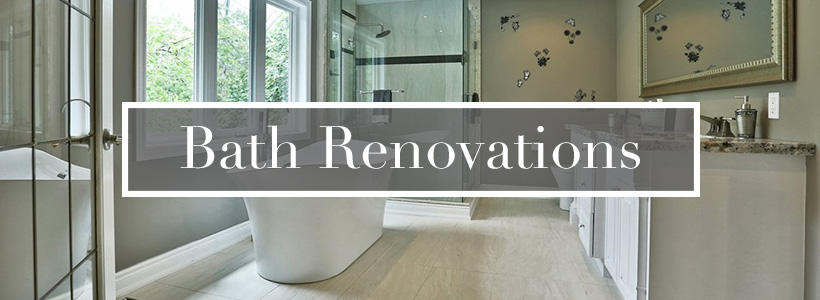
Mildew! The uninvited guest in the party that is your bathroom. Where there’s moisture, however, there will be mildew, so it’s a common issue in bathrooms throughout the Toronto area. Once it pops up, it can be frustrating to figure out how to get rid of it, as well as keep it from coming back. If you just ignore it, mildew will continue to grow and spread. The best way to take care of mildew is to clean it up as soon as you spot it. But what is mildew? Is it mold? Can it make someone sick? And what’s the best way to remove it? Let’s take a look at this pesky little fungus and talk about how to rid our bathrooms of it.
Why Does Mildew Grow?
Mildew thrives in environments where it stays warm and damp, which means that a shower is like a mildew wonderland. You’ll notice mildew popping up along grout lines in your shower, under loose grout (where water has crept), as well as in areas of your shower where water pools or doesn’t dry properly. While mildew is a fungus and so is mold, the two are not the same.
Does Mildew Cause Damage?
Mildew is a surface fungus, which means that it doesn’t typically do damage to bathroom surfaces. We’ll discuss tips for effectively removing mildew from your tile, tub, or shower. Although mildew doesn’t typically cause huge health issues the way mold does, some people can be allergic to it and can have breathing problems, a sore throat, coughing, or headaches as a result of being exposed to it. For this reason, it’s a good idea to nip mildew in the bud as soon as you notice it popping up.
How Should You Remove Mildew?
Especially if you’re allergic to mildew, wear a mask to avoid breathing in any of the spores as you clean. Mildew comes off of most surfaces rather easily. In fact, you can use a scraper or screwdriver to gently scrape at a mildew-covered surface, removing the offending fungus. After you’ve removed the bulk of it, you’ll need to mix up a mildew-attacking cleaning solution.
Wear gloves before preparing the solution. Also ensure that you have good ventilation (both because you’ll be working with bleach and because you want to air out all mildew spores that float free). Mix four cups of water with a half a cup of bleach. Add in your favorite detergent and stir the whole batch up until it foams a bit. Now, you’re ready to scrub! Pour a bit of the solution onto the mildewy areas and let it sit for a minute or two. Grab a no-scratch sponge and scrub away any remaining mildew spots. The detergent will help clean and refresh the entire area and the bleach will kill off any lingering mildew spores. Rinse and you’re done!
Preventing the Return
If you have caulk that’s old, loose, or improperly installed, the only way to prevent moisture from getting underneath it and causing a fresh outbreak of mildew is to rip it out and redo it. Another cause of mildew—particularly if you’re noticing it pop up on your bathroom wall or ceiling—is improper ventilation or air conditioning that’s not working well to air things out and cool things off. Check to ensure that your vents are blowing properly and that your bathroom is receiving proper airflow.
If you have any further questions about mildew in your bathroom or need help repairing, updating, or replacing bathroom features or fixtures, contact the team at Kitchen and Bath.
ADDITIONAL ARTICLES ABOUT BATHROOM RENOVATION:
- 4 Ways to Transform Your Basement
- 5 Tips to Turn Your Bathroom into a Home Spa
- 5 Ways to Create a Senior-Friendly Bathroom
- 6 Benefits of a Written Kitchen Renovations Contract
- 6 Must-Know Requirements when doing Kitchen Renovations Aurora
- 7 Reasons to Consider Winter Kitchen Renovations Milton
- A General Overview of the Home Renovation Process
- A Guide to Permits Required for Kitchen Renovations Nobleton
- About
- Bathroom Fixtures: Choosing the Right Ones
- Bathroom Mildew: How to Deal with It
- Bathroom Mold: Causes and Prevention
- Bathroom Remodel: Is There a Warranty?
- Bathroom Remodelling Do’s and Don’ts
- Bathroom Remodelling: How to Choose High-Quality Materials
- Bathroom Renovation Blog
- Bathroom Renovation Tips to Enjoy Your Experience
- Bathroom Renovation: Planning the Process
- Bathroom Renovations in Oakville, Mississauga
- Bathroom Renovations & Remodeling in Vaughan, Richmond Hill
- Bathroom Renovations Remodeling in Toronto & Etobicoke
- Bathroom Renovations: How to Get Your Perfect Space
- Bathroom Renovations: How to Get Your Perfect Space
- Bathroom Vanities in Toronto & Mississauga
- Caring for your bathroom vanity cabinet
- Choosing the perfect bathroom vanity cabinet
- Should you consider DIY or use a professional
- Choosing the perfectly sized bathroom vanity
- How to install a bathroom vanity
- Getting the most out of your bathroom vanity storage space
- Choosing the correct top for your bathroom vanity
- Caring for a wooden bathroom vanity cupboard
- Bathroom vanity cabinet design trends
- Painting your bathroom vanity cabinet
- Bathroom Visualizer
- Bathtub Materials 101: Things to Know Before Your Bathroom Renovation
- Bathtubs Toronto Mississauga
- Before / After
- Benefits of Installing a Walk- In Tub
- Best Renovation Tips for your Bathroom
- Best Tips for Your Kitchen Renovation
- Blog
- Build Equity with D.I.Y. Projects
- Change Your Living Space Using Crown Molding
- Checklist Before Starting Kitchen Renovations Thornhill
- Common Wallpaper Problems and Solutions
- Consider a Custom Bathroom Renovation
- Contact
- Costs to Remodel Your Bathroom
- Edge Visualizer
- Faucets Toronto Mississauga
- Finish Carpenter Staircase Installation Tips
- Five Tips for a (Mostly) Stress-Free Bathroom Remodel
- Five Ways to Make Your Small Bathroom Seem Huge
- Frameless Shower Doors: The Benefits
- From So-So to Sanctuary: Designing the Bathroom of Your Wildest Dreams
- Future Bathroom Fixtures and Upgrades to Know About
- Great Fire Place Ideas
- Have a Small Bathroom? Tips for Remodeling It
- Have Extra Room in Your Home? Consider These Renovations!
- Having a Plan: The First Step to an Ideal Home Renovation
- Home Renovation Blog
- Home Renovation Company Toronto
- Home Renovation Improvements that Add Value in 2016
- Home Renovations & Remodeling
- Home Renovations = Win/Win for Homeowners
- Home Renovations to Tackle During a Staycation
- Hot Trends in the 2016 Housing Market
- How can you Bring Kitchen Renovations Bolton Costs Down?
- How to Choose the Perfect Bathroom Vanity
- How to Fund Your Home Remodelling Investment
- How to Remodel Your Bathroom While Sticking to a Budget
- How to Transform Your Bedroom and Kick Insomnia Out
- It Pays to Be Realistic: Your Bathroom Remodeling Plan
- It’s Your Choice: Types of Bathroom Faucets
- Jacuzzi – Whirlpool Tub in Mississauga & Toronto
- Keeping Your Bathroom Renovation Environmentally Friendly
- Kitchen & Bath Inc.
- Kitchen Cabinets Toronto
- 5 Storage Solutions for Kitchen Renovations
- All you Need to Know About Kitchen Cabinets
- DIY: Paint Kitchen Cabinets Like a Pro
- How to Get a Trendy Kitchen That Won’t Soon Be Outdated
- How to Select the Perfect Cabinet
- Important Questions to Ask When Shopping for Kitchen Cabinets
- Kitchen Cabinets: 7 Important Things to Know
- Kitchen Cabinets: You Don’t Have to Start from Scratch
- Kitchen Hardware
- Kitchen Remodelling: Cabinet Door Styles 101
- Light or Dark Kitchen Cabinets?
- Modern VS Old: Managing Contemporary Styles
- Redoing Your Kitchen Cabinets? 5 Trends to Know About
- Remodelling 101: Creating an Efficient Kitchen Space
- Shaker Cabinets: The Perfect Choice for All Kitchen Styles
- Should I Hire a Professional for My Kitchen Design?
- Simple Solutions for A Flawless Cabinet Installation
- Storage Solutions for Your Kitchen Made Simple
- The Benefits of Custom Designed Kitchen Cabinets
- Treasured Freatures: Cabinet Storage Trends in 2016
- Yes! You CAN Have Light Kitchen Cabinets and Dark Floors!
- What to Consider When Buying Kitchen Cabinets in 2020
- Kitchen Cabinets Designs: Which is Right for You
- Tips for Staining Kitchen Cabinets
- Cleaning and Caring for Kitchen Cabinets
- How to Choose Contractor for Kitchen Cabinet Installation
- Choosing Kitchen Cabinets: Stock or Custom
- Kitchen Cabinet Colour Schemes & Finishes
- Benefits of Ready to Assemble Kitchen Cabinets
- Tips for Choosing High-Quality Kitchen Cabinets in 2020
- 7 Timeless Colour Combos for your Kitchen cabinet
- 7 Ways to Maximize Storage Space in your Kitchen Cabinets
- 8 Mistakes you want to avoid while painting kitchen cabinets
- Choosing a Kitchen Cabinet Material: A Simple Guide
- Budgeting for your kitchen cabinets
- Cabinet Door Styles to spruce up your kitchen
- Painting your Kitchen cabinets
- The A2Z of Kitchen Cabinetry – Part 1
- The A2Z of Kitchen Cabinetry – Part 2
- The Complete Guide to Refacing your Kitchen Cabinets
- Things to ask your Custom Kitchen Cabinet Maker
- Care and Maintenance Tips for Your Kitchen Cabinets
- Adding More Cabinets to Your Kitchen
- Re-facing Your Tired Kitchen Cabinets
- Painting Your Kitchen Cabinets to Update the Look
- Why You Need to Update Your Kitchen Cabinets
- The Best Way to Clean Your Kitchen Cabinets
- Refreshing Your Kitchen Cabinets
- Ways to Update Your Kitchen Cabinets in 2020
- Are You Getting the Most Out of Your Kitchen Cabinet Space
- Are Your Kitchen Cabinets Making Your Kitchen Look Old and Drab
- Benefits of Choosing Custom Kitchen Cabinets
- Add 5 These Features to Your Kitchen Cabinets
- Painting Your Kitchen Cabinets Doesn’t Have to Be Hard: Tips to Help
- Learn How to Paint Your Kitchen Cabinets: The 101 Guide
- Your Kitchen Cabinet Buying Checklist
- Your Kitchen Cabinet Guide: What to Know and Look For
- Signs You Need to Replace Your Cabinets and Not Reface Them
- Beautiful Kitchen Cabinets: Door and Drawer Options
- Things to Consider When Choosing Kitchen Cabinet Pulls and Knobs
- Kitchen Renovation Blog
- Kitchen Renovation Brampton
- Kitchen Renovation Company Toronto
- Kitchen Renovations and Remodeling in Toronto
- High Quality Plywood is all the Rage in Cabinetry
- How to Avoid Cabinet Painting Mistakes
- How to Spruce Up a Tired Kitchen
- Renovating a Kitchen on a Budget
- Saving on Kitchen Renovation Costs
- Kitchen Renovation Pitfalls You Should Avoid
- The Complete Kitchen Renovation Checklist
- Planning your Kitchen Workflow
- Five Timeless Kitchen Renovation Ideas
- Dos and Don’ts for Kitchen Renovation
- 5 Budget Friendly Kitchen Renovation Ideas for Improved ROI
- Budgeting for your Kitchen Remodel
- Five Kitchen Trends that will define design in 2016
- Selecting the right backsplash
- To repair or replace the countertop during kitchen renovation
- Kitchen Renovations Company Oakville
- Big Ideas for Small Kitchen Spaces
- Custom vs. Factory Made Kitchen Cabinets
- Dark Kitchen Inspiration
- Designing Your Contemporary Kitchen
- French Kitchens
- Gold Kitchen Ideas
- Investment Potential in Renovating your Kitchen
- Kitchen Floors
- Kitchen Lighting Ideas
- Kitchen Renovation Costs
- Kitchen Renovation Design Trends for the New Year
- Kitchen Renovation Ideas – 2020 Edition
- Kitchen Renovation Warranty
- Selecting Countertops for Kitchen Renovation
- Selecting Kitchen Cabinets for Kitchen Renovation
- Simple Guide to Kitchen Renovation
- Top Four Kitchen Ideas for the New Year
- Top Kitchen Accessories
- What We Love and Hate about White Kitchens
- Kitchen Renovations In Burlington
- Kitchen Renovations In Etobicoke
- Kitchen Renovations Vaughan, Richmond Hill
- Kitchen Visualizer
- Kitchen&Bath Blog
- Kitchen&Bath Renovation Guide
- Kitchen&Bath Specials Finder
- Kitchen&Bath Specials Finder PPC
- Latest Trends in the Bathroom Tile You Might Want To Check Out
- Master Bath Suite: You Need One
- Milton Kitchen Renovations & Remodeling
- Modern Kitchens
- Oakville and Mississauga Home Renovations
- 4 Tips To Make Bathroom Renovations Successful
- 5 Common Mistakes To Avoid When Remodeling Your Home
- 5 Kitchen Remodeling Trends In 2020 That Are Here To Stay
- 5 Steps To Renovate During The Winter
- Basement Flooding: How To Avoid It And What To Do When It Happens
- Basement Remodeling Ideas To Create An Entertaining Space
- How To Make Your Home The Perfect Space For Entertaining
- Ideas For Optimal Home Lighting
- Tips For Choosing The Perfect Kitchen Backsplash
- Tips On Choosing The Best Kitchen Sink And Faucet
- Tips On Finding The Perfect Paint Colour
- Top 5 Best Flooring Materials For Bathrooms
- Top Remodeling Trends For Fall Season
- Other Renovations
- Plan for Your Bathroom Remodel! Seriously, Plan for It
- Planning a Bathroom Renovation? Avoid These Common Mistakes
- Planning for the Perfect Renovation
- Practical tips to Design your own Home Theater
- Practical Tips to Transform your Patio or Sunroom
- Privacy Policy
- Projects
- Redesigning Your Small Bathroom Space: Ideas to Consider
- References
- Remodelling Your Oakville/Mississauga Home? 5 Reasons to Install a Guest Bathroom
- Renovating Your Bathroom? 5 Tips for Choosing the Right Bathtub
- Renovating Your Toronto Home in 2020? Here Are A Few Tips!
- Renovation Special
- Renovation Summer Special
- Service
- Shower Column Toronto & Mississauga
- Small Bathroom? We Can Solve This Common Problem
- Small Spaces 101: What to Do with a Small Bathroom
- So You’ve Decided to Renovate Your Bathroom
- Stacked Stone Visualizer
- Strategies and Guidelines for Home Renovations
- Summer Deals
- Summer Deals Confirmation
- Summer Renovations Promo
- Thank you
- Thank you – Promotion Page
- Thank you global
- Thank you Renovating Helper
- The 411 on Bathroom Tile
- The Bathroom Renovation Trend You Shouldn’t Miss
- The Bathtub Conundrum: Keep It or Lose It?
- The Most Common Questions Regarding Home Renovations
- The True Cost of Remodeling Your Bathroom: Tile
- Things to Know about Renovating Your Kitchen
- Time to Renovate! Bathroom Renovation Ideas for Any Home
- Tips for Choosing Bathroom Countertops
- Tips to Lower the Cost of Your Bathroom Renovation
- Tips to Revamp Your Family Room
- Toilets Toronto & Mississauga
- Top 4 Hacks to Create More Space in Small Living Areas
- Top Mistakes Commonly Made with Home Renovations
- Toronto Bathroom Renovations & Remodeling
- Toronto Home Renovations
- Toronto Kitchen Renovations & Remodeling
- Transitional Kitchens
- Vaughan & Richmond Hill Home Renovations
- 5 Simple And Practical Home Renovations If Your Budget Is Limited
- 7 Tips To Renovate Your Home In Spring
- Avoid The Temptation Of DIY Kitchen And Bath Renovations
- Good Reasons To Invest In New Flooring
- How Do I Choose The Perfect Bathroom Tile?
- How To Budget For Your Next Home Renovation Project
- How To Design Your Ideal Bathroom Renovation With Ease
- How To Remodel Your Bathroom For The Spring Season
- How To Transform Your Bathroom Into An At-Home Spa
- Ideas And Tips For Choosing A Bathroom Faucet
- Remodeling Ideas For Your Main Floor
- Tips To Declutter On Your Next Home Renovation
- Tips To Renovate Before Selling Your Home
- Tips To Upgrade To A Master-Chef Kitchen
- What is Covered in a Good Kitchen Renovations Burlington Contract?
- What to Think About When Choosing a New Bathtub
- WholeSale
- Working through your Kitchen Renovation
- Top Bathroom Design Trends for 2016
- Bathroom Renovation Mistakes to Avoid
- The Great Debate: One or Two Bathroom Sinks
- Don’t Forget about Storage When Remodeling Your Bathroom
- What to Think About When Choosing a New Bathtub
- 12 Things to Think About Before You Renovate Your Bathroom
- How to Select the Best Paint Colour for Your Bathroom
- The Truth About Bathroom Paint
- Should I Use Wallpaper in my Bathroom?
- Walk In Shower vs Tub/Shower Combination
- Dos and Don’ts of Bathroom Renovations
- Types of Flooring for a Bathroom
- Pros and Cons of a Radiant Heated Bathroom Floor
- What to Know About Hiring a Contractor
- DIY vs Hiring a Professional
- Tips for Getting Bathroom Tile Right the First Time
- Tips for Tiling a Small Bathroom
- Ten Best Bathroom Renovation Ideas
- Should You Install a Pre-Fabricated Unit or a Tiled Shower?
- Top 10 Bathroom Accessory Trends for 2016
- Tips for Installing a New Bathroom Vanity
- Pedestal vs Vanity Sink
- Budgeting for a Bathroom Renovation
- Professional Renovation Tips from the Experts – 2020 Edition
- Trends in Bathroom Tile
- Bathroom Contractor
- Home
- Kitchen Contractor
- Kitchen Renovation Mississauga





